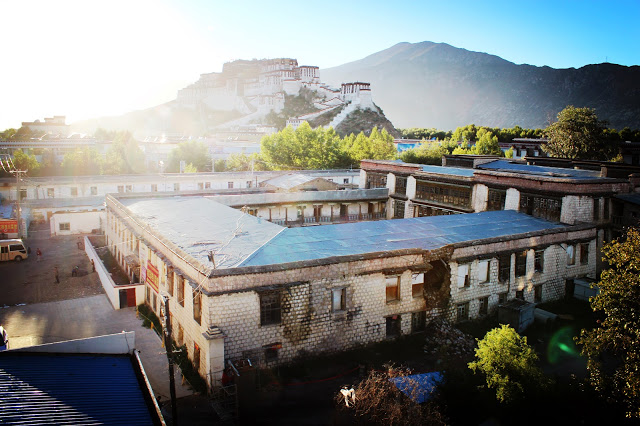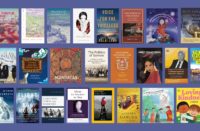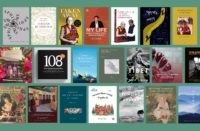
High Peaks Pure Earth has translated a blogpost by Woeser, originally written in two parts in September 2015 for the Mandarin service of Radio Free Asia. The first part was published on her blog on November 17, 2015.
In this post, Woeser writes about the families of the Dalai Lama, known in Tibetan as Yabzhi, and specifically about the official residence of the 14th Dalai Lama in Lhasa. Part Two will be posted next week.
“The Ruins of Lhasa: Yabzhi Taktser” (Part One)
By Woeser
Yabzhi has two Chinese transliterations, Yaxi and Yaoxi. “Yab” is the highest honourific term for father, while “zhi” refers to a clan’s residence. All Tibetans know this term. According to Tibetan traditions and also according to scholarly research, “Yabzhi refers to the family of former Dalai Lamas,” as the Italian Tibetologist, Luciano Petech, states. Official Chinese Tibetologists also claim that “people use the word Yabzhi (the father’s residence), that both connotes power and wealth, to pay respect to the families of Dalai Lamas; Yabzhi has already become a commonly recognised noun.” To be precise, however, we should translate Yabzhi as “the residence of the nation’s founding father”.

Like many other Tibetans, I have also always believed that Tibet has had many different Dalai Lamas and hence, there should also exist many different Yabzhi clans. But scholars say that “now, there are six Yabzhi clans, including the one of the current Dalai Lama.” They are: Sangpo, the clan of the 7th Dalai Lama; Lhalu, the clans of the 8th and 12th Dalai Lamas; Yuthok, the clan of the 10th Dalai Lama; Phunkhang, the clan of the 11th Dalai Lama; Langdun, the clan of the 13th Dalai Lama; and finally Taktser, the clan of the current 14th Dalai Lama who comes from Taktser in Amdo, which, according to today’s Chinese administrative divisions, would be Hongyao Village, Pingan County, Qinghai Province. This illustrates that the title Yabzhi has a specific history. The reason why I decided to elaborate on this here is because I don’t know why, but I have encountered so many Yabzhi families. It seems that many people randomly add the “Yabzhi” title in front of their family names.
I have encountered so many “Yabzhi this” and “Yabzhi that”; for instance, the family of Phagpala, the the Lama from Kham: even his elder brother who once held a Chinese government post added “Yabzhi” in front of his surname. This habit definitely only developed after the Cultural Revolution. Before that, who would have even dared to openly call himself Yabzhi? It was part of the “Four Olds” that were swept into the dustbin of history; at the time, even genuine aristocratic families wished they were blacksmiths or butchers instead; some even quickly “married down”, getting together with “low people” whose shadow they would have even stayed away from before.
But some 20 or 30 years later, things have completely changed again. Today, many Tibetans wished they could somehow suddenly turn into aristocratic families over night. And in order to do so, they spare no efforts to fabricate stories that turn them into relatives of the powerful, into Princes and Princesses. To the point that the children of genuine Rinpoches – those who had passed on their monastic traditions from generation to generation but were forced to return to secular life during those abnormal times – who are pitiful products of this history with no reasons to feel pride, suddenly grant themselves the title of Yabzhi.
All Yabzhi are one family; well, does this mean that all these new “Yabzhi clans” are blood-related?
And what about the real and genuine Yabzhi clans? Where are the traces that the current 14th Dalai Lama left in Lhasa?

Let me draw attention to the photo that was probably taken before 1959, showing a large white building block, looking rather beautiful in the middle of a vast garden area lined with trees. It is located between Lhasa’s old town and the Potala Palace; one can see it when looking down to the left-hand side from the top floor of the palace. This is the Dalai Lama’s official family residence–Yabzhi Taktser Residence, also known as Yabzhi Taktser. From related records we learn that this residence was not adjacent to other aristocratic residences. It was “the only stand-alone residence” in Lhasa’s old town, within the area of the longest prayer wheel path, the Lingkor. It was built in this particular place so that when the Dalai Lama, living high up in the Potala Palace, missed his home and family, he could simply look to the left and see the silhouettes of his siblings, perhaps even smell the fragrance of his mother baking his favourite Amdo bread. The building is also called Changseshar.

2.
In the book “Dalai Lama, My Son: A Mother’s Story” (published in 1997 in Taiwan), the 14th Dalai Lama’s mother, Sonam Tsomo, explains that “Changse” means “under the majestic sight of the Dalai Lama”, “shar” refers to “the eastern side of Potala Palace”. This poetic name reveals the noble and humane character of Lhasa’s aristocrats who helped find this place for the young Dalai Lama and his family who had come from the border region. The building of this special residence located not far from Potala Palace began in 1939 when the Dalai Lama was invited to come to Lhasa. It was completed in around 1941. However, the place was only under the majestic sight of the Dalai Lama for less than 20 years. In the night of March 17, 1959, when the 24-year-old quietly left the already occupied city of Lhasa and embarked upon the long road into exile, his family lost their home.
The mother of His Holiness remembers:
“After our arrival in Lhasa we were given some property that had belonged to the thirteenth Dalai Lama. He had been approached by the British Legation to sell the land, but he refused, saying that it would be useful to him later on. It was called Changseshar. It was a huge property filled with trees.”
“After three years at Norbulingka we moved to this new home … the government had sent someone to inform us that our new house was ready.”
“It became our home. The government had invited Lamas to bless the place; also, we had four Lamas staying with us permanently. On every eighth day we would go and pray. Sometimes we would invite 50 to 100 Lamas to pray with us for an entire week.”
“Our house was of stone and had three storeys and pillars. It was constructed by the Government. A two-story house was built beyond the courtyard.”
“Both these sons were born at Changseshar. The son who lived was named Tenzin Choegyal; he was born in 1946. The son who died was called Tenzin Chodak. He was so lively. He would go to His Holiness’s chambers and upset everything. He died after a bronchial infection that lasted many months. When he died, we invited the Gadong oracle to do a divination.
… While in trance the Gadong oracle said that my dead son was a high personage who had made a prayer that although he was passing away, he would return to his parents.”
“Before the trip (to China), we invited His Holiness to spend a few days at Changseshar. He had never been to see our home, so it was a great honour for me as well as for the whole household. We had to prepare food for His Holiness as well as the entire retinue of government officials and the people who waited to seek an audience with him. It was a great responsibility. Prayers were held daily prior to his departure on a long trip. The entire Kashag and many aristocrats were present. We built a new kitchen before he arrived, as well as a new driveway, in the event his car would drive up to the house.”

In the autobiography, I noticed two photographs of His Holiness’s mother standing on the roof of Changseshar. They were taken during Losar. She was dressed in a chuba, but the colourful brocades on both of her shoulders indicated that this was not a traditional chuba, but one from Amdo. Other than earrings, she was not wearing any jewelry, looking simple but stylish. After her husband’s death, as she writes, she would only wear Amdo brocades or other jewelry for very special occasions. On one of the photos she is holding the young Ngari Rinpoche dressed in a robe. When he followed His Holiness into exile, he was already a young boy. I also saw a photo showing His Holiness’s mother with her three sons, behind them a traditional Tibetan-style door with a door hanging; it is not clear, however, whether this was a door to Changseshar.
3.
However, when the Chinese army entered Lhasa, everything changed. With regards to the early years, His Holiness’s mother recalls: “The Chinese came to Changseshar and told me it would be a good idea to convert the place into government offices. They wanted to pay me cash, but I refused. They said that if I did not accept money, people would later say they had robbed me … They dropped in anytime they wanted. Whenever they told me they were coming, I felt nervous wondering what they would talk about. When they left, I felt light and heaved a sigh of relief. I was so afraid. I had to be very careful what I said, or else I might hurt some other party through careless words.”

She also remembers the day when they left Changseshar. It was on March 10, 1959. The Tibetan resistance against the Chinese government had already started, but His Holiness’s mother had not yet noticed anything, she was still at home working on her embroidery and completing her housework duties. It was still tranquil inside Changseshar, even though at the bottom of Potala Palace, thousands of women were shouting slogans to protect the Dalai Lama. When the wife of the head guard of His Holiness came to pick her up and bring her to live at Norbulingka, she wrote bitterly:
“I did not know that it was the last I would see of Changseshar and my mother. I did not even have time to pack anything, just left for India.
“I had locked everything in Changseshar and left the keys wrapped in silk, with a note attached for my chang-zo (housekeeper) … I told him to take charge of the house and that I was placing the keys in his custody … I did not even have time to bid farewell to my mother; no time to get clothing, we just left…”
His Holiness’s grandmother was already 87 years old and could not travel on a horseback. She had to stay behind, dying a lonely death two years later in the city of Lhasa that was in the process of being turned upside down.
Several decades later, when I went to visit Changseshar, I failed to find anything reminding us of the wonderful past. I was instead confronted with a totally different scene. I was confronted with signs reading “the second guest house” of the TAR government; or with signs reading “rebel faction” headquarters, referring to one of Lhasa’s main rebel bases where Red Guards were received from all across China during the Cultural Revolution, causing all sorts of damage. Later on, it was turned into a hotel and the rooms were used by staff. The place turned into a big messy compound where everyone just minded their own business.
I would say that Yabzhi Taktser should be one of Lhasa’s important landmarks, it is just as significant as any other old building, but only very few people know about it. Then again, that is also positive because it is less likely to be destroyed by tourists. In fact, this building, the former residence of the Dalai Lama’s parents, has been quite fortunate. Even though it is already run-down and keeps disintegrating, it is not likely to completely collapse any time soon; also, about two thirds are still in their original location. It is true that after the Dalai Lama’s family fled to India, the place was deprived of its power by “liberators” – newly rich dressed in green clothes, to follow Vladimir Nabokov’s description – and it was appropriated by the revolution, serving as shelter for various kinds of people, but if you ask people today, no one would tell you that this used to be the residence of His Holiness; they would simply say that this is the Tibetan Mansion.
 4.
4.
Last summer, a Tibetan netizen whose screen name is “Snowland Dust” posted 16 photos showing Yabzhi Taktser exterior and interior on his blog. They must have been taken over a decade ago, as the buildings appear to be quite intact. One can still see the heads of the Communist monsters that had been drawn onto the inner wall: Marx, Engels, Lenin, Stalin and Mao.

The netizen even added some introductory words: “After long negotiations between the Tibetan government and the Dalai Lama’s parents, especially his father, they decided to build this residence about 500 metres to the east of Potala Palace; the building time roughly dates back to the time between 1939 and 1941.” “It occupies a total area of around 3500 square metres, with a floor area of about 2700 square metres. It was built in traditional Tibetan style, without any special or modern components. The entire place is separated into two main areas, the inner and outer courtyards. The outer one is two storeys high and was mainly used by servants and official personnel accompanying the Dalai Lama. The inner courtyard is three storeys high and served as a place for the Dalai Lama and other important officials. The whole place encompasses around 100 bigger and smaller rooms (including storage rooms). It is located in the most flourishing commercial street of today’s Lhasa (Beijing Middle Road) and the surrounding shops facing towards the street completely cover it up. Not many people know that this was once the residence of the Dalai Lama’s parents.”
This netizen is definitely familiar with the inside story, as he writes: “During the turmoil of the Cultural Revolution, there existed three basic reasons as to why some historical sites and aristocratic manors were not completely destroyed: first, they were used by the military; second, they served as offices or guest houses for the government; or third, they became storerooms of people’s communes or places for other collective activities. The Dalai Lama’s manor was saved because it was turned into a government guest house: its name was ‘the second government guesthouse’”.
Yabzhi Taktser “was confiscated by the Chinese government in 1964 and served as a guesthouse until 1990, fulfilling a very important function for government officials of all ranks in times when the Chinese economy was not yet as developed as it is now.”
“In 1990, the local government built a new and modern hotel called Tibetan Mansion. It was a semi-commercial government hotel and the original ‘second government guesthouse’ (the residence of the Dalai Lama’s parents) became part of this Tibetan Mansion. From 1990 until 2005, the rooms inside were rented out to hotel staff, mainly Chinese workers. Around the courtyard area, they built many commercial houses. These commercial houses have been collectively known as the ‘Tibetan Mansions’ department for economic development’.” “They are still generating economic revenue today. Until 2011, the usage, renting and commercial activities in these buildings generated a total of around 66 million Yuan.”

Also, “the interior of the original building has been altered quite significantly. The main room was separated into two parts to increase income from rent. Moreover, several offices were built for staff to manage the tenants and collect rent. The wall paintings in many rooms have already been wiped off, it probably already happened when it was still a government guesthouse. This is especially true for the main scripture hall and the Dalai Lama’s chamber where most of the murals and carvings have been erased. But the painting of Mao Zedong, Stalin and others is still on the interior wall.”
September 2015
The photos below come from “Snowland Dust’” blog (http://tibetinmyview.wordpress.com/图文说西藏/). The original post has already disappeared. The photos must have been taken around ten years ago, if not even earlier.














Thank you!!!!!